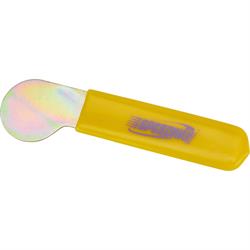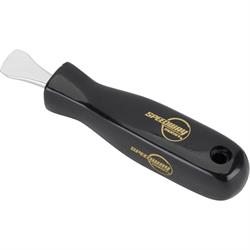Selecting Quarter-Turn Fasteners

What Are Quarter-Turn Fasteners?
The simple quarter-turn fastener design was invented by William Dzus in the early 1930s with manufacturing in Islip, NY. The Dzus fastener (pronounced like "Zeus fastener") is what Mr. Dzus called it and it worked perfectly for securing panels that required frequent and quick removal, yet could withstand high loads and severe vibration without loosening. The self-locking feature is very strong—safe enough that the aircraft industry and our military began using them. Today quarter-turn fasteners have been the standard for all kinds of racing and street rod applications. From hood scoops, body panels, and interior pieces, to access panels, or you name it; if there’s a will, there’s a way you can put them to good use. Much like the term "Kleenex" is used for facial tissue, the name "Dzus fastener" is often used to describe quarter-turn fasteners no matter the manufacturer, but you will also hear the terms spiral cam fasteners or turnlock fasteners.
How Many Types of Quarter-Turn Fasteners Are There?

Depending on what type of quarter-turn fastener you’re looking for, Speedway offers several options to choose from. We supply plastic, aluminum, or steel fasteners, which feature large or small heads. You can also choose from oval head, flush mount, or butterfly head designs. The lengths range from .400- to .800-inch reach in order to fit a variety of material widths, while the fastener's shank is available in two sizes; 5/16- and 7/16-inch. Self-ejecting fasteners are designed with a spring that creates tension for quick release and it holds the button in place after being released. This is a common option used on drag racing, oval track and off-road applications where speed is critical and to prevent fastener loss. Additional details are provided below.
Shank sizes
- Two shank sizes are offered 5/16” and 7/16”
- 5/16” size refers to the diameter of the shank and measure .31” outside diameter
- 7/16” shank size fasteners actually measure .40” which is slightly smaller than a true 7/16” measurement
Reach Lengths
- Available from .400” to .800” length
- Length is measured from the bottom of the head to the bottom of the spring
Head designs
- Oval head design is one of the most commonly used types. The head has a crown or domed top and offers the greatest strength
- Available in a standard head size as well as large head which has a 1-1/8-inch head
- Flush mount has a tapered head and will be flush with the panel when fastened. These require extra work to dimple the material during installation.
- Butterfly head does not require tools to remove or install the fastener. Works great for access panels that are frequently used.
Material types
- Steel fasteners offer the greatest strength but are the heaviest
- Aluminum fasteners are much lighter than steel and offer enough strength for many applications
- Plastic fasteners are the lightest but are significantly weaker than aluminum versions. Added benefit is the plastic doesn’t mar the surface of your panel as much as the metal fasteners do.
Self-ejecting
- Fastens to the panel so that when released the quarter turn fastener stays attached to the panel–no searching for lost fasteners
- Spring under the head of the fastener holds it in the ejected position allowing easy removal of the panel
- We offer a flush mount design that is attached to the panel with 1/8” rivets
What Does The Quarter-Turn Fastener's Spring Do?

The quarter-turn fastener utilizes a spring, which are typically secured to a spring plate that is held in place with two rivets. The quarter-turn fastener's tip locks into the spring when rotated, securing the two parts of the fastener (and thus the panels they are mounted to) together. Speedway offers two types of springs: a flat spring, and a ¼-inch stepped spring. The thickness of the material you're using will determine which spring and fastener to use. The ¼-inch stepped-spring is used when the material thickness is considerably thin or thick. The stepped-spring can be flipped over and used with thinner material with a shorter-reach fastener. Take your measurement by adding the thickness of the material to the installed spring height. The installed height of a flat spring is approximately .150-.175 inches, and a stepped spring is .400-.425 inches. Read on for additional details on these springs, mounting plates, and how to properly measure for your application.
Quarter-Turn Fastener Springs
As noted above, you will find quarter-turn fastener springs in both flat and stepped designs, with the stepped design providing the freedom of installing with the step facing up or down to accommodate your material thicknesses. Most quarter-turn fastener springs are installed with 1/8-inch rivets to the spring plate. Matter of fact, all quarter-turn springs we offer mount as such. You will need our 1/8-inch rivets for quarter-turn fasteners to install the springs to the spring plates and the spring plates to your panel/frame.
Available spring lengths include 1-3/8-inch and 1-inch length springs (measured center to center of coiled mounting eyelets)
- 1” springs are typically used along with 5/16-inch shank size fasteners but they can also be used with 7/16-inch
- 1-3/8-inch springs are typically used along with 7/16-inch shank size fasteners
1-3/8-inch springs are available in a flat or stepped version:
- flat springs measure .150-.175-inch installed height
- stepped springs measure .400”-.425” installed height
1-inch springs are available in two heights .200-inch and .375-inch, both of which are a flat profile

Quarter Turn Fastener Spring Mount Plates
Spring mounting plates are commonly used to fasten a panel onto tubing or a chassis (Example: Most of the body panels of a Sprint car are fastened to the chassis using spring plates). For street cars spring mount plates are often used in conjunction with self-ejecting quarter-turn fasteners for things like fiberglass hoods, hood scoops, and interior access panels.
Traditionally available in mild steel to allow for easy welding to a chassis or other steel body panel, spring mount plates are offered in both 1-inch and 1-3/8-inch hole spacing. Lightweight and scalloped versions are available to save weight in applications where every ounce counts. A scalloped version is shown here to the left. The lightweight/scalloped versions are also more aesthetically pleasing on racing applications where the plates are highly visible.
How To Measure For Proper Quarter-Turn Fastener Installation
Length and material thickness calculations are critical to ensuring your quarter-turn fastener has the proper reach and grip to allow full engagement with the spring to the fastener. Too large a gap and the fastener won't reach, while too little a gap will cause panel rattling/fitment issues and/or allow the fastener to loosen/disengage.
The quarter-turn measuring guide illustration shown here (and linked for a larger version) will aid you in obtaining the proper quarter-turn fasteners, springs, and spring plates for your project.

Letter A in the measurement guide is your total material thickness and must include the top layer of material, bottom layer of material and/or spring plate if used. Some installations will have several thickness of material stacked up so be sure to compensate for all layers between the spring and the head of the fastener.
Letter B is the spring height. Two different spring heights are available to help compensate for different material thickness being fastened.
Letter C is the quarter turn fastener length. This length needs to be equal to or very close to the sum of A and B. Example: Material thickness (A) of .350-inch plus spring height (B) of .150-inch= .500-inch (C) quarter turn fastener length.
Installation tip – If your quarter turn fastener is just a bit too long and does not tightly hold the material together you can adjust this by bending the spring slightly. Use a large flat blade screwdriver to push on the spring through the fastener hole. If access from the back side is available then pliers can be used to pull on the spring.
Useful Tools for Quarter-Turn Fasteners and Springs

-A) Avoid measuring and save yourself the time by using a transfer punch tool. You simply slide this guy over the spring, hold your panel in place and lightly tap with a rubber hammer. Now you have a mark to drill out for your fastener.
-B) If you’re using flush-mount fasteners, the Moroso dimple tool is ideal for countersinking the sheet metal. The two-piece design is zinc plated and transfers a precise .866-inch overall dimple. It can be used with single or double panel sheet metal.
-C) How annoying is it when you try using a tool that isn't right for the job? Screwdrivers never seem to quite fit right, so we designed fastener tools that are specifically sized for quarter-turn fastener heads. Choose from economy, deluxe, or premium, all guaranteed to make life easier during the chaotic rush of the pits.
- Another great little helper (not pictured here) is the quarter-turn fastener hole setting tool. This tool aids in locating the proper drilling point in your panel in relation to your already installed spring mount plate and spring. This makes installing a replacement panel on a race car that already has spring mount plates and springs welded-riveted in place
Updated by Mark Houlahan











